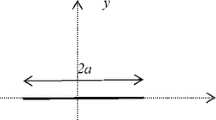Abstract
Crack tip plasticity is simulated as motion of discrete dislocations. The results of the dislocation model are compared with the predictions of a continuous description of crack tip plasticity in the case of a stationary mode I fatigue crack. It is shown that both the dislocation model and the continuum mechanics lead to the same result at high loading levels but they differ significantly for small stress intensity ranges.
Similar content being viewed by others
References
Dai, S.-H. and Li, J.C.M. (1982). Dislocation-free zone at the crack tip. Scripta Metallurgica 16, 183–188.
Davidson, D.L. and Lankford, J. (1992). Fatigue crack growth in metals and alloys: mechanisms and micromechanisms. International Material Reviews 37, 45–76.
Hong, S.I. and Laird, C. (1991). Faceted fatigue fracture and its relations to the crystallographic slip systems in Cu-16 at. pct. Al single crystals. Metallurgical Transactions A 22A, 415–425.
Huang, H. and Gerberich, W.W. (1992). Crack-tip dislocation emission arrangements for equilibrium — II. Comparison to analytical and computer simulation models. Acta Metallurgica et Materialia 40, 2873–2881.
Kobayashi, S. and Ohr, S.M. (1980). In situ fracture experiments in bbc metals. Philosophical Magazine A 42, 763–772.
Lii, M.-J., Chen, X.-F, Katz, Y. and Gerberich, W.W. (1990). Dislocation modeling and acoustic emission observations of alternating ductile/brittle events in Fe-3wt pct. Si crystals. Acta Metallurgica et Materialia 38, 2435–2453.
Lin, I.H. and Thomson, R. (1986). Cleavage, dislocation emission and shielding for cracks under general loading. Acta Metallurgica et Materialia 34, 187–206.
Nabarro, F.R.N. (1967). In: Theory of Crystal Dislocations (Edited by N.F. Mott, E.C. Bullard, D.H. Wilkinson), Oxford University Press, London.
Nix, K.J. and Flowers, H.M. (1982). The micromechanisms of fatigue crack growth rate in a commercial Al-Zn-Mg alloy. Acta Metallurgica et Materialia 30, 1549–1559.
Pippan, R. (1991). Dislocation emission and fatigue crack growth threshold. Acta Metallurgica et Materialia 39, 255–262.
Pippan, R. and Riemelmoser, F.O. (1995). Dislocation shielding of fatigue cracks. Zeitschrift für Metallkunde 86, 823–826.
Pippan, R. (1992). The condition for the cyclic plastic deformation of the crack tip: the influence of dislocation obstacles. International Journal of Fracture 58, 305–318.
Rice, J.R. (1967). Mechanics of crack tip deformation and extension by fatigue. Fatigue Crack Propagation, ASTM STP 415, American Society of Testing Materials, 247–311.
Rice, J.R. and Thomson, R. (1974). Ductile versus brittle behaviour of crystals. Philosophical Magazine A, 73–97.
Rice, J.R. (1992). Dislocation nuclcation from a crack tip: An analysis based on the peierls concept. Journal of the Mechanics and Physics of Solids 40, 239–271.
Ritchie, R.O. and Suresh, S. (1981). Some considerations on fatigue crack closureat near-threshold stress intensities due to fracture surface morphology. Metallurgical Transactions A 13A, 937–940.
Schöck, G. (1991). Dislocation emission from crack tips. Philosophical Magazine A 63, 111–120.
Zhu, T., Yang, W. and Guo, T. (1996). Quasi-cleavage processes driven by dislocation pileups. Acta Materialia 44, 3049–3058.
Author information
Authors and Affiliations
Rights and permissions
About this article
Cite this article
Riemelmoser, F.O., Pippan, R. & Stüwe, H.P. A comparison of a discrete dislocation model and a continuous description of cyclic crack tip plasticity. International Journal of Fracture 85, 157–168 (1997). https://doi.org/10.1023/A:1007386208842
Issue Date:
DOI: https://doi.org/10.1023/A:1007386208842




